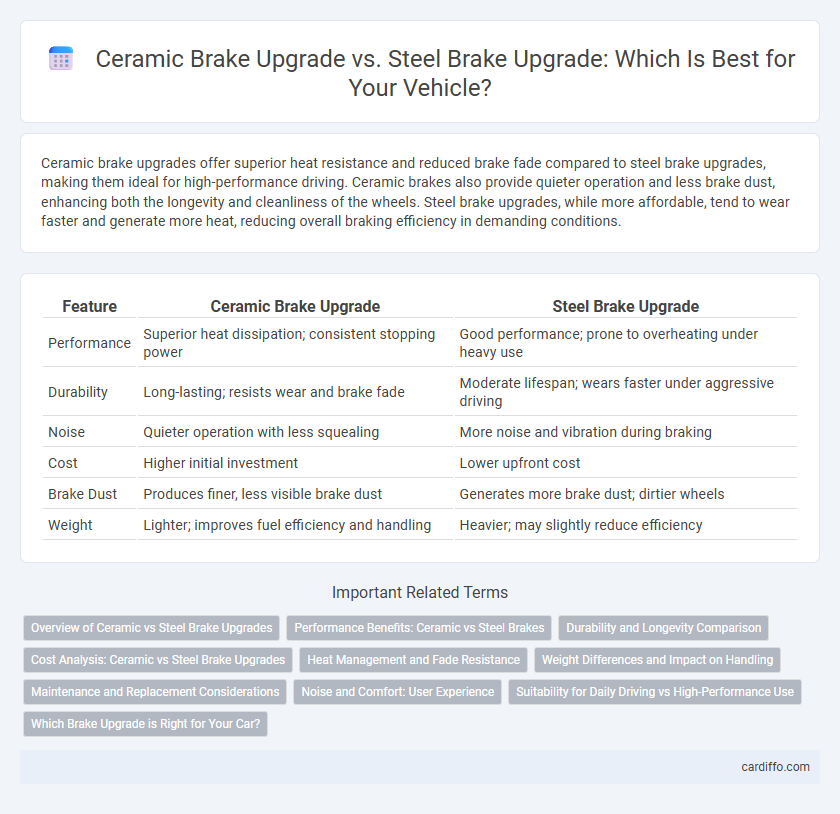Ceramic brake upgrades offer superior heat resistance and reduced brake fade compared to steel brake upgrades, making them ideal for high-performance driving. Ceramic brakes also provide quieter operation and less brake dust, enhancing both the longevity and cleanliness of the wheels. Steel brake upgrades, while more affordable, tend to wear faster and generate more heat, reducing overall braking efficiency in demanding conditions.
Table of Comparison
| Feature | Ceramic Brake Upgrade | Steel Brake Upgrade |
|---|---|---|
| Performance | Superior heat dissipation; consistent stopping power | Good performance; prone to overheating under heavy use |
| Durability | Long-lasting; resists wear and brake fade | Moderate lifespan; wears faster under aggressive driving |
| Noise | Quieter operation with less squealing | More noise and vibration during braking |
| Cost | Higher initial investment | Lower upfront cost |
| Brake Dust | Produces finer, less visible brake dust | Generates more brake dust; dirtier wheels |
| Weight | Lighter; improves fuel efficiency and handling | Heavier; may slightly reduce efficiency |
Overview of Ceramic vs Steel Brake Upgrades
Ceramic brake upgrades offer superior heat resistance, reduced brake fade, and longer lifespan compared to steel brakes, making them ideal for high-performance and heavy-duty vehicles. Steel brake upgrades provide strong stopping power and durability at a lower cost, suitable for everyday driving and moderate use. Choosing between ceramic and steel brake upgrades depends on driving conditions, budget, and performance requirements, with ceramics excelling in temperature management and steel in cost-effectiveness.
Performance Benefits: Ceramic vs Steel Brakes
Ceramic brake upgrades offer superior heat dissipation and reduced brake fade compared to steel brakes, enhancing high-performance driving reliability. They provide lighter weight, which improves overall vehicle handling and acceleration by reducing unsprung mass. In contrast, steel brakes are more cost-effective but tend to wear faster and generate more brake dust, affecting long-term maintenance and performance consistency.
Durability and Longevity Comparison
Ceramic brake upgrades offer significantly enhanced durability compared to steel brakes, with ceramic compounds resisting wear and heat buildup more effectively. This results in longer lifespan and consistent performance under high-temperature conditions, reducing the need for frequent replacements. Steel brakes, while often more affordable, tend to wear down faster and suffer from corrosion, leading to shorter overall longevity.
Cost Analysis: Ceramic vs Steel Brake Upgrades
Ceramic brake upgrades typically cost between $1,000 and $2,000, offering longer lifespan and superior heat resistance compared to steel brakes, which generally range from $300 to $700. Although steel brake upgrades are more affordable initially, ceramic brakes provide better performance and reduced maintenance costs over time. Evaluating total cost of ownership reveals ceramic brakes as a cost-effective investment for high-performance and long-term use.
Heat Management and Fade Resistance
Ceramic brake upgrades offer superior heat management compared to steel brakes, as their advanced materials dissipate heat more efficiently under extreme conditions. This enhanced thermal conductivity significantly reduces brake fade, maintaining consistent stopping power even during prolonged or aggressive braking. Steel brakes, while durable, tend to retain more heat, leading to quicker performance degradation and reduced fade resistance during high-stress driving scenarios.
Weight Differences and Impact on Handling
Ceramic brake upgrades typically offer a significant reduction in weight compared to steel brake upgrades, often saving several pounds per wheel. This weight reduction decreases unsprung mass, enhancing suspension responsiveness and overall vehicle handling. Lighter ceramic brakes improve acceleration, cornering stability, and braking performance by reducing rotational inertia.
Maintenance and Replacement Considerations
Ceramic brake pads typically offer longer lifespan and produce less brake dust compared to steel brake pads, reducing maintenance frequency and cleaning efforts. Steel brake pads may require more frequent replacement due to faster wear but generally cost less upfront. Both options demand regular inspection to ensure optimal braking performance and safety.
Noise and Comfort: User Experience
Ceramic brake pads significantly reduce noise levels compared to steel brake pads due to their advanced friction material composition, providing a quieter driving experience. The superior heat dissipation properties of ceramic brakes also enhance ride comfort by minimizing brake dust and vibration. Users consistently report smoother braking performance and less cabin disturbance with ceramic brake upgrades, making them ideal for those prioritizing noise reduction and comfort.
Suitability for Daily Driving vs High-Performance Use
Ceramic brake upgrades offer superior heat dissipation and reduced brake fade, making them ideal for high-performance use, while maintaining lighter weight to enhance vehicle responsiveness. Steel brake upgrades provide robust durability and consistent stopping power better suited for daily driving conditions, with lower cost and easier maintenance. Choosing between ceramic and steel brakes depends on prioritizing track-level performance or reliable everyday functionality.
Which Brake Upgrade is Right for Your Car?
Ceramic brake upgrades offer superior heat resistance and reduced brake dust compared to steel brakes, making them ideal for high-performance and daily driving. Steel brake upgrades provide a budget-friendly option with reliable stopping power, suitable for everyday use and heavier vehicles. Choosing the right brake upgrade depends on your driving style, vehicle type, and desired balance between performance and maintenance.
ceramic brake upgrade vs steel brake upgrade Infographic

 cardiffo.com
cardiffo.com